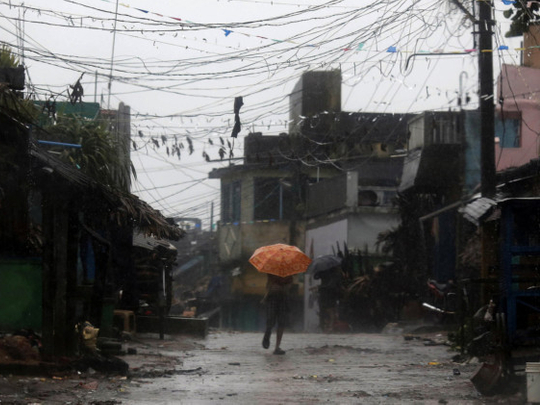
New Delhi: India completed its biggest ever evacuation ahead of the arrival of Cyclone Phailin, the national disaster agency said on Sunday, with about a million people moved from their homes.
"We were preparing for a super cyclone, but Phailin did not turn into a super cyclone," spokeswoman for the National Disaster Management Agency, Tripti Parule, said by phone.
"The last biggest evacuation in India's recorded history was in Andhra Pradesh in 1990 [when another cyclone struck], and this is now much bigger."
Powered its way inland over eastern India leaving a swathe of destruction but the loss of life appeared limited.
It was the strongest storm to hit India in 14 years.
Torn branches littered a road running past destroyed huts and twisted electricity poles along a large stretch of the east coast.
At least five people were killed — four people by falling trees and one when the walls of her mud house collapsed as the storm roared in off the Bay of Bengal, authorities said.
The cyclone was one of three major storms over Asia on Sunday. The smaller Typhoon Nari was approaching Vietnam and Typhoon Wipha loomed over the Pacific.
More than half a million people in India spent the night in shelters, some built after a storm killed 10,000 people in 1999.
Others took refuge in temples.
By first light, winds had slowed to 90kph from top speeds of 200kph when the storm made landfall near the town of Gopalpur in Odisha state on Saturday night.
Television images showed cars flipped on their sides and debris-strewn streets in the silk producing city of Brahmapur, one of the hardest hit. A few trucks and motor-bikes returned to the city’s streets as residents emerged to survey the damage.
Large swathes of Odisha, including its capital, were without electricity for a second day after the storm ripped down power cables, and officials said it was too early to give an accurate damage assessment.
“We will assess after the cyclone eases ... even now the cyclone is on,” said Odisha’s chief secretary J.K Mohapatra.
“There has been pretty severe devastation in Brahmapur town.”
Extensive flooding
Soldiers and rescue workers in helicopters, boats and trucks will fan out across Odisha and neighbouring Andhra Pradesh state to review the damage. The India Meteorological Department warned of extensive flooding and destruction of flimsy homes.
Higher sea levels driven by storm surges can cause the worst destruction. Phailin was forecast to drive sea levels up 3.5 metres at its peak.
At least 550,000 people were crammed into shelters including schools and temples, in what the National Disaster Management Authority called one of India’s largest evacuations.
In Mogadhalupadu, a fishing village in Andhra Pradesh, where some people had refused to leave their boats and nets, the damage was less than feared. Seawater surged into huts made from coconut palms near the beach.
“People have come back to the village now,” said village chief Jagdesh Dasari, saying winds that gusted through the night had dropped off and the rain was light.
Operations at Paradip port in Odisha have been halted since Friday. All vessels were ordered to leave the port, which handles coal, crude oil and iron ore. An oil tanker carrying 2 million barrels of oil, worth $220 million, was moved.
The storm landed far north of India’s largest gas field, the D6 natural gas block in the Cauvery Basin further down the east coast, operated by Reliance Industries.












